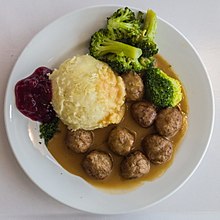Köttbullar
Köttbullar (pronunciation in Swedish : [ ˈɕœtˌbɵlːar ]) are traditional Swedish meatballs that are fried with cranberry compote or jam, cream sauce and boiled potatoes or mashed potatoes . In the German translation, kött-bullar corresponds to meat rolls (plural).
history
According to a statement from the Swedish government in April 2018, the Swedish meatballs are based on a recipe that King Charles XII. brought back from the Ottoman Empire , where he stayed for five years at the beginning of the 18th century. So Köttbullar would have a Turkish origin, which explains their similarity to Köfte from Turkish cuisine . However, this representation was rejected as a modern myth by the Swedish nutrition historian Richard Tellström in the newspaper Dagens Nyheter . In the article he explained in more detail that these meatballs were already known in Sweden before the Swedish king was imprisoned in the Ottoman Empire, albeit under the name frikadell . The expression köttbulle for these meatballs appears for the first time in a cookbook by Anna Christina Warg (called Cajsa Warg ) from 1755. She points out that these little dumplings can be made from veal as well as from sheep or ox meat: Kiöttbullar giöres på samma sätt som desse små bullar, with hwilka denna ofwanstående rätt bör garneras; Dock kunna de giöras af rått kiött så wäl som af stekt, also afwen af får eller oxkiött.
preparation
Köttbullar are prepared like meatballs , made from finely chopped minced meat , egg , breadcrumbs and onions . The breadcrumbs are soaked in milk or cream, the finely chopped onions are steamed before being incorporated. They are seasoned with salt , pepper and a little allspice , possibly also some ginger powder . After the balls have been fried in butter, a sauce can be made from the roast set. In Sweden and Finland, Köttbullar are also made from elk meat. As cold bread dish they are at the Swedish Smörgås -Variation Köttbullesmörgås usually together with beetroot salad served (Swedish: "Köttbullesmörgås med rödbetssallad").
Worldwide distribution
Köttbullar are known around the world primarily for the self-service restaurants and grocery departments of the Swedish furniture chain IKEA . Astrid Lindgren set them a literary monument as the favorite dish of their children's book novel character Karlsson vom Dach . In Finland they are called köttbullar lihapyörykät or lihapullat , and in Turkey they are called “Swedish Köfte”. In Germany they are also offered under the product name “meatball balls”.
Individual evidence
- ↑ Kris Bramwell, Dilay Yalcin: Swedish meatball admission: They're Turkish . In: BBC News , May 1, 2018.
- ↑ Judith Vonberg: Abbasolute scandal: Swedish meatballs are really Turkish . In: CNN.com , May 3, 2018.
- ↑ Måltidshistorikern: En myt att köttbullen är turkisk , dn.se, May 3, 2018 (Swedish)
- ↑ The cookbook is titled Hjelpreda I Hushållningen För Unga Fruentimber (household helper for young women) sv.wikisource.org
- ↑ Hjelpreda I Hushållningen För Unga Fruentimber - Allehanda slag af Kalf , Kiöttbullar , sv.wikisource.org
Web links
- Jens Hansegard: Ikea Köttbullar. The rise of the meatball. sueddeutsche.de , October 20, 2013, accessed June 17, 2014 .
